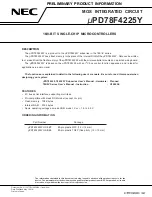
During both calibration processes, no correct receive or transmit operation is possible. The recommended state for
the calibration is therefore PLL_ON, but calibration is not blocked at receive or transmit states.
Both calibrations can be executed concurrently.
7.6.5
Interrupt Handling
Two different interrupts indicate the PLL status (refer to the IRQ_STATUS register). IRQ_0 (PLL_LOCK) indicates
that the PLL is locked. IRQ_1 (PLL_UNLOCK) interrupt indicates an unexpected unlock condition. A PLL_LOCK
interrupt clears any preceding PLL_UNLOCK interrupt automatically and vice versa.
An IRQ_0 (PLL_LOCK) interrupt is supposed to occur in the following situations:
• State change from TRX_OFF to PLL_ON / RX_ON
• Frequency setting change in states PLL_ON / RX_ON
• A manually started center frequency calibration completed
All other PLL_LOCK interrupt events indicate that the PLL locked again after a prior unlock happened.
An IRQ_1 (PLL_UNLOCK) interrupt occurs in the following situations:
• A manually initiated center frequency calibration in states PLL_ON / (RX_ON)
• Frequency setting change in states PLL_ON / RX_ON
Any other occurrences of IRQ_1 (PLL_UNLOCK) indicate erroneous behavior and require checking of the actual
device status.
PLL_LOCK and PLL_UNLOCK affect the behavior of the transceiver:
In states BUSY_TX and BUSY_TX_ARET, the transmission is stopped and the transceiver returns into state
PLL_ON. During BUSY_RX and BUSY_RX_AACK, the transceiver returns to state RX_ON and RX_AACK_ON,
respectively, once the PLL is locked.
Notes:
1.
An AT86RF212B interrupt IRQ_0 (PLL_LOCK) clears any preceding IRQ_1 (PLL_UNLOCK) interrupt
automatically and vice versa.
2.
The state transition from BUSY_TX / BUSY_TX_ARET to PLL_ON / TX_ARET_ON after successful
transmission does not generate an IRQ_0 (PLL_LOCK) within the settling period.
7.7
Automatic Filter Tuning (FTN)
The Automatic Filter Tuning (FTN) is incorporated to compensate device tolerances for temperature and supply
voltage variations, as well as part-to-part variations of the radio transceiver. The filter-tuning result is used to correct
the analog baseband filter transfer function and the PLL loop-filter time constant.
An FTN calibration cycle is initiated automatically when entering the TRX_OFF state from the P_ON, SLEEP or
RESET state.
Although receiver and transmitter are very robust against these variations, it is recommended to initiate the FTN
manually if the radio transceiver does not use the SLEEP state. If necessary, a calibration cycle is to be initiated in
states TRX_OFF, PLL_ON or RX_ON. This applies in particular for the High Data Rate modes with a much higher
sensitivity against Band-Pass Filter (BPF) transfer function variations. The recommended calibration interval is five
minutes or less, if the ATSAMR30M18A operates always in an active state (PLL_ON, TX_ARET_ON, RX_ON and
RX_AACK_ON).
7.7.1
Overview
The Automatic Filter Tuning (FTN) is incorporated to compensate device tolerances for temperature, supply voltage
variations as well as part-to-part variations of the radio transceiver. The filter-tuning result is used to correct the
analog baseband filter transfer function and the PLL loop-filter time constant.
An FTN calibration cycle is initiated automatically when entering the TRX_OFF state from the P_ON, SLEEP or
RESET state.
Although receiver and transmitter are very robust against these variations, it is recommended to initiate the FTN
manually if the radio transceiver does not use the SLEEP state. If necessary, a calibration cycle is to be initiated
ATSAMR30M18A
Module Description
©
2018-2021 Microchip Technology Inc.
and its subsidiaries
Datasheet
DS70005384B-page 29
















































